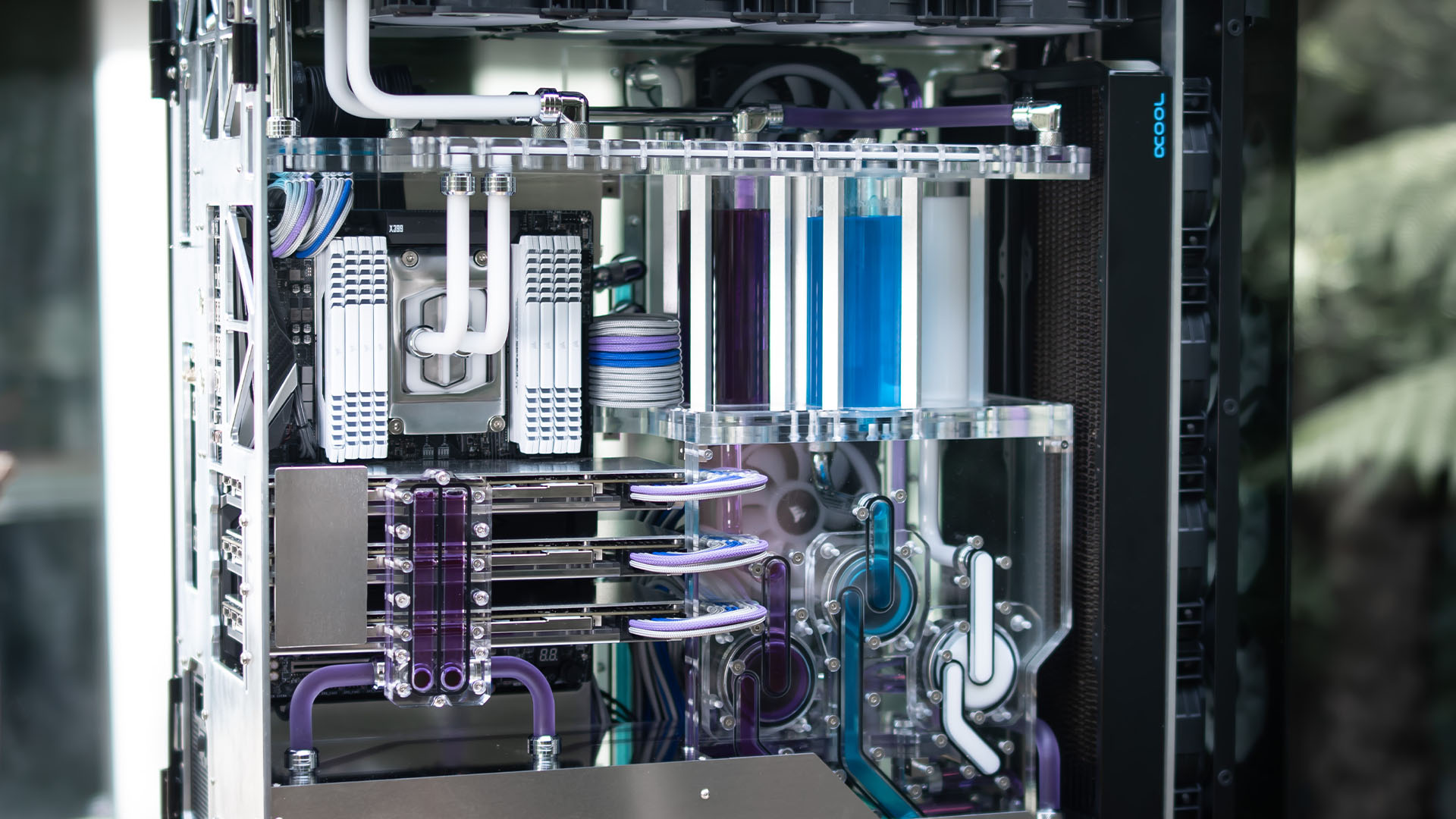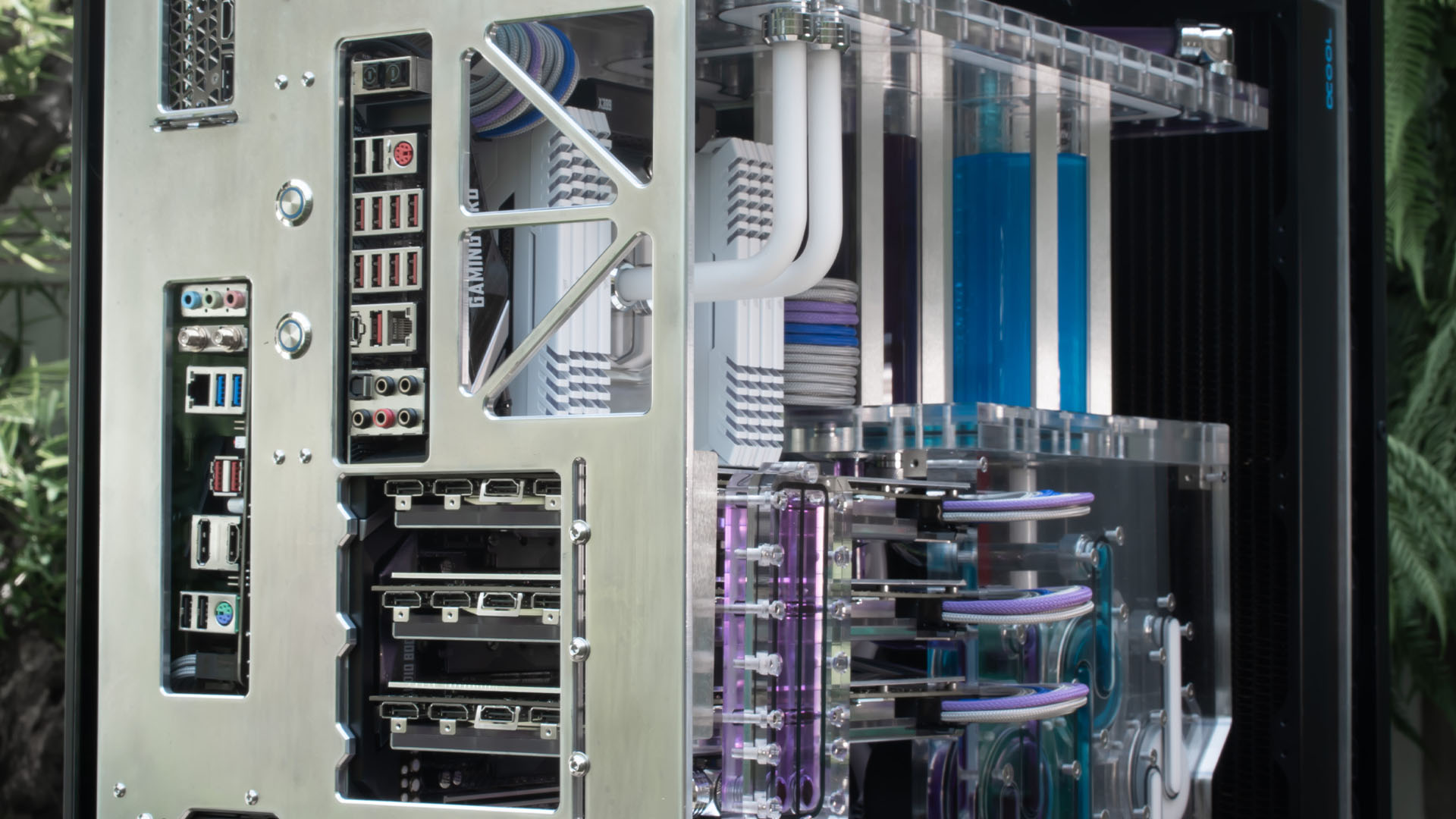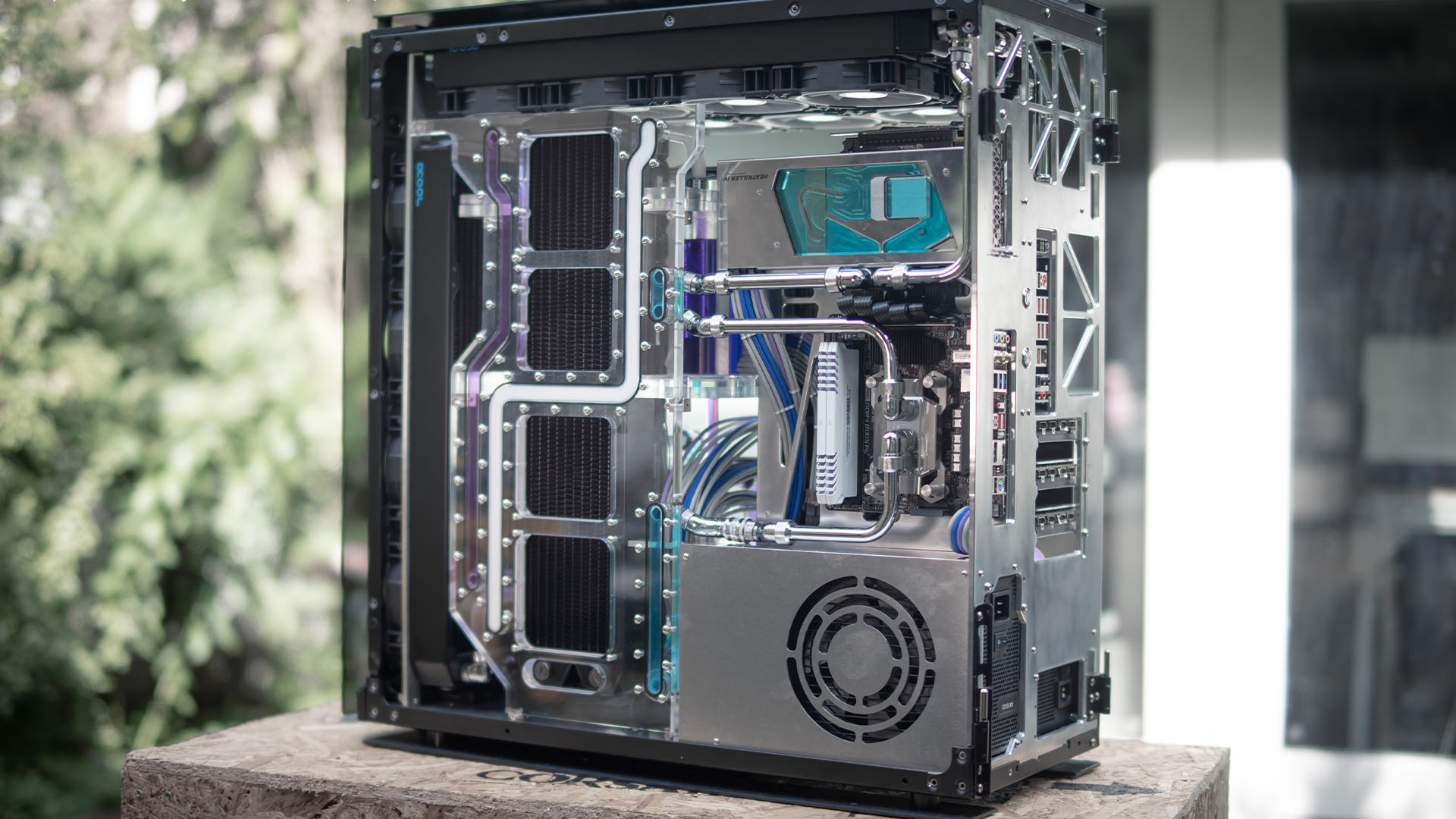We’ve by no means seen a gaming PC that’s so filled with gear as this gorgeous twin water-cooled Corsair Obsidian 1000D construct. Created by professional PC modder Alexander Banks to point out off at Corsair tech reveals, this unimaginable dual-system incorporates 4 Nvidia GPUs, three water-cooling loops, and a great deal of customized cables.
Due to our quickly rising PC constructing Fb web page, we’ve seen many customized gaming PCs, from mods based mostly on present case designs to scratch PC builds. You possibly can even submit yours for consideration proper right here. Right here we discuss to Alexander about how he created this gorgeous twin water-cooled PC construct.
: Why did you employ the Corsair 1000D for this construct?
Alexander: Corsair approached me with the concept of constructing a show-stopping rig to be used at occasions such, naturally in its (on the time) new Obsidian 1000D tremendous tower chassis. I’ve by no means actually constructed an excessive machine by way of each scale and specs earlier than and positively not with the fabrication strategies to which I now have entry, so it was fairly an thrilling proposition.
What specs did you select, and why?
The principle goal of this construct is a showcase. In different phrases, overkill in as many areas as doable. The 1000D is a dual-system chassis, so it was vital to retain that function, even when it was in a closely modified type. We opted to go for an AMD Threadripper principal system, so we might fill the case with Nvidia GeForce GTX 1080 Ti GPUs, reminiscence, SSDs and a real motive for together with such a beefy cooling system.
For the secondary system, we caught to mini-ITX with a Ryzen CPU, however nonetheless sporting a GeForce GTX 1080 Ti. For the cooling, it appeared solely becoming that the construct was fitted with an equally excessive setup – there are three separate cooling loops, seven distribution plates, and 5 480mm radiators.
What difficulties did you come throughout?
In all probability the toughest half was merely filling up the case. The 1000D is monumental, and attempting to make use of up all that area isn’t any imply feat. That mentioned, the additional I bought into the undertaking, the smaller it started to really feel. Three loops and 5 radiators take up quite a lot of area, to not point out all of the cabling required for the power-hungry parts.
Designing all of the coolant routes in order that they didn’t intersect with essential cables, or structural components of the case, was very difficult too. Equally, it was vital to make the case really feel full, however not busy. The cables go by the distribution plates to allow them to be stored neat and ordered. Likewise, the tubing runs are stored quick and solely use a single bend at most – each half has a route and a motive.

How did you make the distribution plates?
The plates had been first sketched by hand so I might work out the most effective routes to try – I discover it a lot simpler to start out this manner moderately than leaping straight into CAD. They had been then drafted in Autodesk Fusion 360 and inserted into the broader 3D mannequin of the entire construct to test the becoming.
Lastly, I tool-pathed all of them and exported them to chop from acrylic on the CNC router. Having the ability to do all of this work in-house felt very liberating, even when some components had been maybe just a little formidable given my restricted sensible expertise with it. After reducing, it was merely a matter of constructing O-rings to offer a watertight seal and fastening the plates collectively.
One of many key components of this construct was integrating the three tube reservoirs into the distro plates. I wished them to be very seen, but in addition labored into the plates in a manner that meant there have been no tubes entering into nor out. So far as I knew, this design hadn’t been completed earlier than, so it felt fairly thrilling and novel.
What instruments and equipment did you employ?
This construct used fairly an in depth variety of instruments and strategies, due to its scope. Nearly all of the heavy work was achieved with the CNC router, which I used to assemble the 5mm aluminum panels and distro plates. There was nonetheless modifying work to be accomplished inside, although; reducing with jigsaws, drills and angle grinders. Plus, in fact, there are all of the cabling-related instruments – I made all of the cables from scratch for this construct.
All of the panels had been additionally polished after reducing in order that they might mirror the lights inside, including some visible aptitude. There’s simply one thing about thick-cut metallic that appears moderately particular when polished to a satin end.
The CNC was very a lot a brand new software for me, and proved to have fairly a studying curve. Whereas I’d already designed components to be minimize in earlier mods, designing and producing in-house is an entire totally different kettle of fish. It’s actually thrilling, not least as a result of you possibly can prototype and push the boundaries a bit.

How lengthy did the construct take?
All in all, it took about two months of labor. There was quite a lot of prototyping, and nearly all the inner construction was changed within the course of too. Whereas it’s unmistakably a Corsair 1000D, there’s actually little or no left of the unique chassis.
The cabling for this construct was a severe endeavor too – the chosen design requires a number of units of cables and extensions so as to stay remotely sensible. It’s fully doable to do all of it with a single set, however swapping any alterations then turns into nearly not possible with out redoing a big portion of the construct the identical manner.
What have you ever discovered from this construct?
That cables take a very long time! In truth, it was additionally a trial-by-fire of types for studying tips on how to use the CNC machine, together with plenty of different instruments within the workshop. Time administration is a key level too. There have been so many components to run in parallel on this construct in a brief area of time – having to develop a extra environment friendly workflow system might be going to be one of the essential factors I’ll take away from this construct.
Are you pleased with the top end result, and is there something you’d do otherwise for those who constructed it once more?
Whereas I’m very a lot pleased with the ultimate end result, I at all times find yourself being my very own greatest critic. If I did it once more I’d undoubtedly change the inner construction to make it simpler to fill and drain the water-cooling system. The rig wasn’t actually designed to be versatile by way of what {hardware} configurations it could possibly settle for, so making some adjustments to the best way explicit parts are mounted and related would possible add quite a bit to the construct’s usability.
I can also’t stand the tinting on the inventory doorways of the case both. They’re so darkish that once they’re positioned on the case you possibly can’t see inside it in any respect, even with all of the RGB followers blaring at full depth. Maybe switching to a plain glass panel with the identical form would enhance this example significantly – I left off the panels in all of the pictures for that reason.

Twin water-cooled Corsair 1000D specs
System 1
- CPU: AMD Threadripper 2950X
- Graphics playing cards: 3 x Nvidia GeForce GTX 1080 Ti Founders Version
- Storage: 3 x 480GB Corsair MP500 NVMe
- Reminiscence: 64GB Corsair Vengeance RGB White 3200MHz DDR4
- Motherboard: MSI X399 Gaming Professional Carbon AC
- PSU: Corsair AX1600i
System 2
- CPU: AMD Ryzen 7 2700X
- GPU: Nvidia GeForce GTX 1080 Ti Founders Version
- Storage: 480GB Corsair MP500 NVMe
- Reminiscence: 32GB Corsair Vengeance RGB White 3200MHz DDR4
- Motherboard: MSI B350I Professional AC ITX
- PSU: Corsair SF600
Cooling for each programs: 5 x 480mm Alphacool NexXxos XT45 radiators with 20 x Corsair LL120 RGB followers; 3 x separate cooling loops for the TR4 CPU, GPUs, and mini-ITX system; Watercool Heatkiller TR4, AM4, and 4 x GPU blocks; 3 x Watercool Heatkiller Tube glass reservoirs; Alphacool Eiszapfen fittings and angled adapters; 13mm Alphacool Eisrohr satin acrylic tubing; 13mm chrome plated brass tubing, 3 x Alphacool VPP 655 Vario pumps
Wow, Alex actually delivered on his temporary to create a show-stopping system right here – this can be a gorgeous construct. There’s simply a lot happening, from the stainless cable work to the a number of hardline water-cooling loops, to not point out the killer {hardware} on the time. If you happen to’re new to the world of water-cooling and wish to have go your self, then ensure you additionally learn our full information on tips on how to water-cool your PC.
This put up initially appeared on Customized PC, which has been protecting wonderful setups for over 20 years and is now a part of . Be part of our almost 500k member Fb group to debate this construct.
If you happen to take into account your self to be an professional PC builder, you possibly can submit your personal customized PC construct to us as we speak for an opportunity of being featured on sooner or later.

